Fact Sheet Bureau of Democracy, Human Rights and Labor and Bureau of Public Affairs Washington, DC December 19, 2003 Mass Graves of Iraq: Uncovering Atrocities
[Brochure in pdf format
(2.64 MB)] Introduction The discovery of mass graves in Iraq graphically testifies to the brutality of Saddam Hussein’s regime and the challenges of building a more pluralistic and law-based state. Both the dead and the living are victims of the crimes that are buried in these graves. We cannot bring back the hundreds of thousands of missing Iraqis. However, identification of as many bodies as possible and accountability for the circumstances of their deaths will enable them to move forward to build a society that respects and protects fundamental human rights and dignity. “Iraqi citizens must have both eyes open: one looking to the future, and the other looking to the past.” Mass Graves Most of the graves discovered to date correspond to one of five major atrocities perpetrated by the regime.
Opponents and critics of the regime from all religious and ethnic groups were also executed and buried in mass graves. Many of these are believed to be located at or near prisons and former military establishments. These crimes have acquired a measure of notoriety and salience. Thousands of other Iraqis, including Marsh Arabs, Shi’a Muslims in the 1970s and 1980s, and students involved in uprisings in Najaf in 1999 may also be lying in mass graves in Iraq. Mass Grave Strategic Plan The Coalition Provisional Authority (CPA), in cooperation with the interim Iraqi Human Rights Ministry, is implementing a program to identify remains in the graves and collect evidence of past atrocities for future prosecutions. These objectives address the needs of grieving families and the demands of accountability and justice. The program was developed in consultation with Iraqi specialists, international human rights groups, and renowned forensic experts. Public Awareness and Education The first phase of the plan, carried out in the first weeks after the war, addressed the need for public awareness and education. Military and CPA investigators, attorneys and forensic experts engaged in extensive efforts to collect, coordinate and verify information on reported mass graves. In addition, the media, nongovernmental organizations (NGOs), and local and religious leaders helped alert Iraqis to the importance of the sites and the need to preserve them undisturbed, and to encourage individuals to come forward with information about suspected sites. When necessary, military and civilian teams deployed to key sites to assist local leaders counsel patience and encourage orderly methods of recovery. Limited training was provided to mitigate damage to sites overrun by an emotional population, including:
The initial “rush to the graves” by grieving Iraqi families quickly slowed, and reports indicate that only 11 of the hundreds of known sites were disturbed.
An Iraqi woman mourns next to remains of bodies exhumed from a mass grave. ©AP photo. The second step of the plan involves formally gathering evidence. The forensic site assessment involves gathering information such as precise location, number of remains in the grave, approximate date of the grave, origin of victims and other information on site condition such as soil, weather and logistical needs. In May 2003, the International Forensic Centre of Excellence for the Investigation of Genocide (INFORCE), a British NGO, contracted with the British Government to work with the CPA to develop standard protocols to govern the forensic work. INFORCE experts also performed 15 initial forensic site assessments. Since then, teams from Denmark, the United Kingdom, and the United States have performed forensic site assessments in coordination with the CPA Forensic Team. The Finnish Government plans to send a team in January 2004. Exhumations. Of the sites that are assessed, the current plan is to select between 8 and 20 for full exhumation consistent with the following criteria:
International teams will conduct the exhumations and, whenever possible, work alongside Iraqis to train them to conduct future exhumations themselves. The Swedish Government has expressed willingness to donate a tenting system to house forensic teams on-site during their work. Training and Iraqi Involvement Longer term specialized training for expert personnel in forensic exhumation and investigation is also being planned, based upon recent assessments of Iraq’s forensic capacity. Selected Iraqi doctors and archaeologists are currently receiving initial training on humanitarian identification procedures, but there is a great need for additional training to ensure that remains are handled in a dignified manner. Iraqi medical examiners will need international assistance, training, and funding to rehabilitate and equip Iraqi forensic labs. Mass graves provide many answers. They tell the story of what happened to loved ones – and when –
Iraqis are currently discussing how to create an Iraqi Bureau of Missing Persons or similar entity to centralize information on missing persons found at mass graves, in documents (such as execution orders), and through witness testimony. Iraqis are also discussing how they will prosecute the perpetrators of crimes against humanity and war crimes in Iraq through an Iraqi-led process assisted and supported by the international community. The photos in this publication were taken at various mass grave locations in Iraq and are strong evidence of Sadam Hussein's brutality.
| |||||
This site is managed by the Bureau of Public Affairs, U.S. Department of State. External links to other Internet sites should not be construed as an endorsement of the views contained therein. |
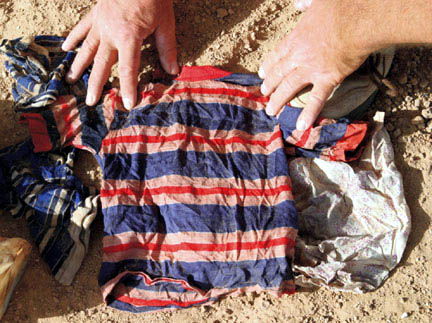
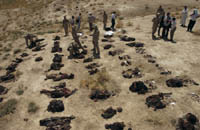 and ethnic group in Iraq as well as foreign nationals, including Kuwaitis and Saudis. Over 250 sites have been reported, of which approximately 40 have been confirmed to date. Over one million Iraqis are believed to be missing in Iraq as a result of executions, wars and defections, of whom hundreds of thousands are thought to be in mass graves.
and ethnic group in Iraq as well as foreign nationals, including Kuwaitis and Saudis. Over 250 sites have been reported, of which approximately 40 have been confirmed to date. Over one million Iraqis are believed to be missing in Iraq as a result of executions, wars and defections, of whom hundreds of thousands are thought to be in mass graves.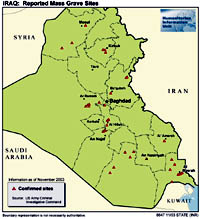
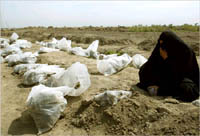
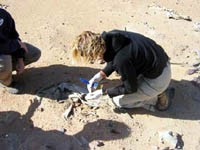 Evidence Gathering and Forensic Site Assessment
Evidence Gathering and Forensic Site Assessment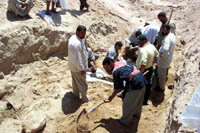 the process in order to show progress as quickly as possible. Accordingly, programs are under way to train Iraqis in community-led exhumations, with a focus on humanitarian identification of the missing. This will enable Iraqis to conduct and participate in exhumations of those mass graves not selected for full forensic exhumation by international teams.
the process in order to show progress as quickly as possible. Accordingly, programs are under way to train Iraqis in community-led exhumations, with a focus on humanitarian identification of the missing. This will enable Iraqis to conduct and participate in exhumations of those mass graves not selected for full forensic exhumation by international teams. 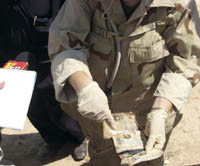 and they corroborate the stories about who was accountable. These answers are essential for promoting reconciliation and justice.
and they corroborate the stories about who was accountable. These answers are essential for promoting reconciliation and justice.